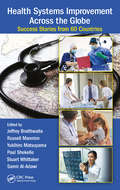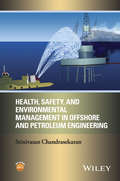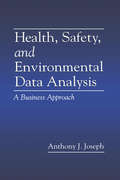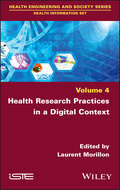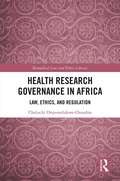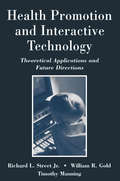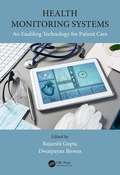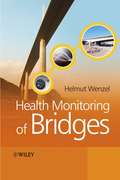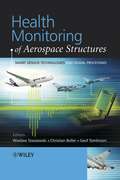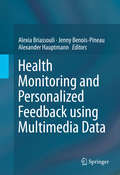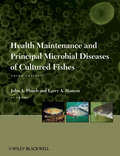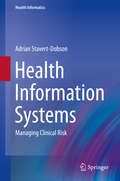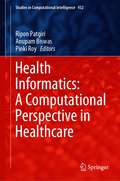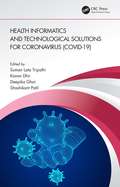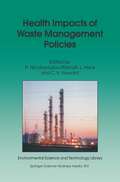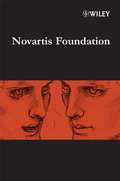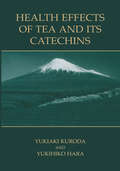- Table View
- List View
Health Systems Improvement Across the Globe: Success Stories from 60 Countries
by Jeffrey Braithwaite Russell Mannion Yukihiro Matsuyama Paul Shekelle Stuart Whittaker Samir Al-AdawiFollowing on from 2015’s Healthcare Reform, Quality and Safety: Perspectives, Participants, Partnerships and Prospects in 30 Countries, this book encompasses a global perspective on healthcare while shifting the focus from reform to showcasing success stories of healthcare systems worldwide. It provides explanations of why various facets of healthcare systems work well in different contexts and offers the reader alternative models for consideration. The book features contributions from 60 countries, going much further than the common practice of focusing on affluent Western nations, to provide a comprehensive exploration of the success of healthcare systems globally. The majority of literature on health-sector improvement attempts to address the problems within systems, relating the errors that can and do occur, for example, and offering solutions and preventative strategies. This book of country case studies will approach the enhancement of health systems, patient safety and the quality of care in a new and innovative way, comprehensively surveying and synthesizing the success stories of healthcare systems around the world, utilizing Hollnagel’s Safety-II approach to acknowledge the importance of exploring what goes right, what works well, and why it works. These success stories may include reference to macro, meso or micro levels of healthcare systems, various sectors (e.g., aged care, acute care or primary care), or specific programs or projects. Health System Improvement Across the Globe: Success Stories from 60 Countries is unprecedented in terms of both reach and positive emphasis, and as such will be instrumental in changing ways of thinking about and guiding health-sector improvement.
Health Systems Improvement Across the Globe: Success Stories from 60 Countries
by Jeffrey Braithwaite Russell Mannion Yukihiro Matsuyama Paul Shekelle Stuart Whittaker Samir Al-AdawiFollowing on from 2015’s Healthcare Reform, Quality and Safety: Perspectives, Participants, Partnerships and Prospects in 30 Countries, this book encompasses a global perspective on healthcare while shifting the focus from reform to showcasing success stories of healthcare systems worldwide. It provides explanations of why various facets of healthcare systems work well in different contexts and offers the reader alternative models for consideration. The book features contributions from 60 countries, going much further than the common practice of focusing on affluent Western nations, to provide a comprehensive exploration of the success of healthcare systems globally. The majority of literature on health-sector improvement attempts to address the problems within systems, relating the errors that can and do occur, for example, and offering solutions and preventative strategies. This book of country case studies will approach the enhancement of health systems, patient safety and the quality of care in a new and innovative way, comprehensively surveying and synthesizing the success stories of healthcare systems around the world, utilizing Hollnagel’s Safety-II approach to acknowledge the importance of exploring what goes right, what works well, and why it works. These success stories may include reference to macro, meso or micro levels of healthcare systems, various sectors (e.g., aged care, acute care or primary care), or specific programs or projects. Health System Improvement Across the Globe: Success Stories from 60 Countries is unprecedented in terms of both reach and positive emphasis, and as such will be instrumental in changing ways of thinking about and guiding health-sector improvement.
Health, Safety, and Environmental Management in Offshore and Petroleum Engineering
by Srinivasan ChandrasekaranThis book shares the technical knowhow in the field of health, safety and environmental management, as applied to oil and gas industries and explains concepts through a simple and straightforward approach Provides an overview of health, safety and environmental (HSE) management as applied to offshore and petroleum engineering Covers the fundamentals of HSE and demonstrates its practical application Includes industry case studies and examples based on the author's experiences in both academia and oil and gas industries Presents recent research results Includes tutorials and exercises
Health, Safety, and Environmental Management in Offshore and Petroleum Engineering
by Srinivasan ChandrasekaranThis book shares the technical knowhow in the field of health, safety and environmental management, as applied to oil and gas industries and explains concepts through a simple and straightforward approach Provides an overview of health, safety and environmental (HSE) management as applied to offshore and petroleum engineering Covers the fundamentals of HSE and demonstrates its practical application Includes industry case studies and examples based on the author's experiences in both academia and oil and gas industries Presents recent research results Includes tutorials and exercises
Health, Safety, and Environmental Data Analysis: A Business Approach
by Anthony J. JosephProfessionals in environmental health and safety (EHS) management use statistics every day in making decisions. This book was created to provide the quantitative tools and techniques necessary to make important EHS assessments. Readers need not be statistically or mathematically inclined to make the most of this book-mathematical derivations are kept to a minimum and subjects are approached in a simple and factual manner, complemented with plenty of real-world examples. Chapters 1-3 cover knowledge of basic statistical concepts such as presentation of data, measurements of location and dispersion, and elementary probability and distributions. Data gathering and analysis topics including sampling methods, sampling theory, testing, and interference as well as skills for critically evaluating published numerical material is presented in Chapters 4-6. Chapters 7-11 discuss information generation topics-regression and correlation analysis, time series, linear programming, network and Gnatt charting, and decision analysis-tools that can be used to convert data into meaningful information. Chapter 12 features six examples of projects made successful through statistical approaches being applied. Readers can use these approaches to solve their own unique problems.Whether you are a EHS professional, manager, or student, Health, Safety, and Environmental Data Analysis: A Business Approach will help you communicate statistical data effectively.
Health, Safety, and Environmental Data Analysis: A Business Approach
by Anthony J. JosephProfessionals in environmental health and safety (EHS) management use statistics every day in making decisions. This book was created to provide the quantitative tools and techniques necessary to make important EHS assessments. Readers need not be statistically or mathematically inclined to make the most of this book-mathematical derivations are kept to a minimum and subjects are approached in a simple and factual manner, complemented with plenty of real-world examples. Chapters 1-3 cover knowledge of basic statistical concepts such as presentation of data, measurements of location and dispersion, and elementary probability and distributions. Data gathering and analysis topics including sampling methods, sampling theory, testing, and interference as well as skills for critically evaluating published numerical material is presented in Chapters 4-6. Chapters 7-11 discuss information generation topics-regression and correlation analysis, time series, linear programming, network and Gnatt charting, and decision analysis-tools that can be used to convert data into meaningful information. Chapter 12 features six examples of projects made successful through statistical approaches being applied. Readers can use these approaches to solve their own unique problems.Whether you are a EHS professional, manager, or student, Health, Safety, and Environmental Data Analysis: A Business Approach will help you communicate statistical data effectively.
Health Research Practices in a Digital Context
by Laurent MorillonThe current “generalized digitization” of society is influencing the health environment, healthcare organizations as well as actors. In this context, human and social sciences deconstruct, nuance and sometimes even challenge certain preconceived ideas and/or dominant discourses. In this book, researchers of four nationalities and three different disciplines have agreed to open the “black box” of their work. They display their scientific practices from the perspective of epistemology, ethics and methodology. They present and analyze their values and postulates but, also, what may have influenced the project, the definition of the object and objectives, as well as their approaches. In a contextual way, the first part presents some changes in environments and infocommunicational practices related to digital health. The second part opens space to reflect on ethics and deontology. Finally, postulating that scientific fact is not an essence but the result of a process, the last part discusses the methods implemented, which may be different from those initially envisaged. This book is dedicated to the researchers and postgraduate students in the human and social sciences as well as the health practitioners likely to collaborate with them.
Health Research Practices in a Digital Context
by Laurent MorillonThe current “generalized digitization” of society is influencing the health environment, healthcare organizations as well as actors. In this context, human and social sciences deconstruct, nuance and sometimes even challenge certain preconceived ideas and/or dominant discourses. In this book, researchers of four nationalities and three different disciplines have agreed to open the “black box” of their work. They display their scientific practices from the perspective of epistemology, ethics and methodology. They present and analyze their values and postulates but, also, what may have influenced the project, the definition of the object and objectives, as well as their approaches. In a contextual way, the first part presents some changes in environments and infocommunicational practices related to digital health. The second part opens space to reflect on ethics and deontology. Finally, postulating that scientific fact is not an essence but the result of a process, the last part discusses the methods implemented, which may be different from those initially envisaged. This book is dedicated to the researchers and postgraduate students in the human and social sciences as well as the health practitioners likely to collaborate with them.
Health Research Governance in Africa: Law, Ethics, and Regulation (Biomedical Law and Ethics Library)
by Cheluchi Onyemelukwe-OnuobiaThe globalisation of research has resulted in the increased location of research involving humans in developing countries. Countries in Africa, along with China and India, have seen research grow significantly. With emerging infectious diseases, such as Ebola and Zika, emphasising the risk of public health crises throughout the world, a further increase in health research, including clinical research in developing countries, which are often the sites of these diseases, becomes inevitable. This growth raises questions about domestic regulation and the governance of health research. This book presents a comprehensive and systemic view of the regulation of research involving humans in African countries. It employs case studies from four countries in which research activities continue to rise, and which have taken steps to regulate health research activity: South Africa, Nigeria, Kenya, and Egypt. The book examines the historical and political contexts of these governance efforts. It describes the research context, some of the research taking place, and the current challenges. It also looks at the governance mechanisms, ranging from domestic ethical guidelines to legal frameworks, the strengthening of existing regulatory agencies to the role of professional regulatory bodies. The book analyses the adequacy of current governance arrangements within African countries, and puts forward recommendations to improve the emerging governance systems for health research in African and other developing countries. It book will be a valuable resource for academics, researchers, practitioners and policy-makers working in the areas of health research, biomedical ethics, health law and regulation in developing countries.
Health Research Governance in Africa: Law, Ethics, and Regulation (Biomedical Law and Ethics Library)
by Cheluchi Onyemelukwe-OnuobiaThe globalisation of research has resulted in the increased location of research involving humans in developing countries. Countries in Africa, along with China and India, have seen research grow significantly. With emerging infectious diseases, such as Ebola and Zika, emphasising the risk of public health crises throughout the world, a further increase in health research, including clinical research in developing countries, which are often the sites of these diseases, becomes inevitable. This growth raises questions about domestic regulation and the governance of health research. This book presents a comprehensive and systemic view of the regulation of research involving humans in African countries. It employs case studies from four countries in which research activities continue to rise, and which have taken steps to regulate health research activity: South Africa, Nigeria, Kenya, and Egypt. The book examines the historical and political contexts of these governance efforts. It describes the research context, some of the research taking place, and the current challenges. It also looks at the governance mechanisms, ranging from domestic ethical guidelines to legal frameworks, the strengthening of existing regulatory agencies to the role of professional regulatory bodies. The book analyses the adequacy of current governance arrangements within African countries, and puts forward recommendations to improve the emerging governance systems for health research in African and other developing countries. It book will be a valuable resource for academics, researchers, practitioners and policy-makers working in the areas of health research, biomedical ethics, health law and regulation in developing countries.
Health Promotion and Interactive Technology: Theoretical Applications and Future Directions (Routledge Communication Series)
by Richard L. Street William R. Gold Timothy ManningThis book's purpose is to offer various perspectives relating to the development, effectiveness, and implementation of interactive computing technology for health promotion--programs and interventions aimed at improving various health-related outcomes such as involvement in care, quality of life, adherence, disease management, healthy lifestyle, and more. Its coverage includes: *conceptual foundations for examining how characteristics of media, messages, and users relate to one another and how interactive media can effectively and appropriately promote health outcomes; *examinations of the development, utilization, and evaluation of specific computer applications for health promotion featuring discussions of the theoretical rationale for the program, the targeted audience, research on the program's effectiveness, and implications for future program development; and *analyses of critical issues such as potential benefits and limitations of technology on the delivery of care, institutional obstacles to the adoption of computing technology, and prospects for integrating information technology into the health system.
Health Promotion and Interactive Technology: Theoretical Applications and Future Directions (Routledge Communication Series)
by Richard L. Street Timothy R. Manning William R. GoldThis book's purpose is to offer various perspectives relating to the development, effectiveness, and implementation of interactive computing technology for health promotion--programs and interventions aimed at improving various health-related outcomes such as involvement in care, quality of life, adherence, disease management, healthy lifestyle, and more. Its coverage includes: *conceptual foundations for examining how characteristics of media, messages, and users relate to one another and how interactive media can effectively and appropriately promote health outcomes; *examinations of the development, utilization, and evaluation of specific computer applications for health promotion featuring discussions of the theoretical rationale for the program, the targeted audience, research on the program's effectiveness, and implications for future program development; and *analyses of critical issues such as potential benefits and limitations of technology on the delivery of care, institutional obstacles to the adoption of computing technology, and prospects for integrating information technology into the health system.
Health Monitoring Systems: An Enabling Technology for Patient Care
by Rajarshi Gupta Dwaipayan BiswasRemote health monitoring using wearable sensors is an important research area involving several key steps: physiological parameter sensing and data acquisition, data analysis, data security, data transmission to caregivers, and clinical intervention, all of which play a significant role to form a closed loop system. Subject-specific behavioral and clinical traits, coupled with individual physiological differences, necessitate a personalized healthcare delivery model for around-the-clock monitoring within the home environment. Cardiovascular disease monitoring is an illustrative application domain where research has been instrumental in enabling a personalized closed-loop monitoring system, which has been showcased in this book. Health Monitoring Systems: An Enabling Technology for Patient Care provides a holistic overview of state-of-the-art monitoring systems facilitated by Internet of Things (IoT) technology. The book lists out the details on biomedical signal acquisition, processing, and data security, the fundamental building blocks towards an ambulatory health monitoring infrastructure. The fundamentals have been complimented with other relevant topics including applications which provide an in-depth view on remote health monitoring systems. Key Features: Presents examples of state-of-the-art health monitoring systems using IoT infrastructure Covers the full spectrum of physiological sensing, data acquisition, processing, and data security Provides relevant example applications demonstrating the benefits of technological advancements aiding disease prognosis This book serves as a beginner’s guide for engineering students of electrical and computer science, practicing engineers, researchers, and scientists who are interested in having an overview of pervasive health monitoring systems using body-worn sensors operating outside the hospital environment. It could also be recommended as a reference for a graduate or master’s level course on biomedical instrumentation and signal processing.
Health Monitoring Systems: An Enabling Technology for Patient Care
by Rajarshi Gupta Dwaipayan BiswasRemote health monitoring using wearable sensors is an important research area involving several key steps: physiological parameter sensing and data acquisition, data analysis, data security, data transmission to caregivers, and clinical intervention, all of which play a significant role to form a closed loop system. Subject-specific behavioral and clinical traits, coupled with individual physiological differences, necessitate a personalized healthcare delivery model for around-the-clock monitoring within the home environment. Cardiovascular disease monitoring is an illustrative application domain where research has been instrumental in enabling a personalized closed-loop monitoring system, which has been showcased in this book. Health Monitoring Systems: An Enabling Technology for Patient Care provides a holistic overview of state-of-the-art monitoring systems facilitated by Internet of Things (IoT) technology. The book lists out the details on biomedical signal acquisition, processing, and data security, the fundamental building blocks towards an ambulatory health monitoring infrastructure. The fundamentals have been complimented with other relevant topics including applications which provide an in-depth view on remote health monitoring systems. Key Features: Presents examples of state-of-the-art health monitoring systems using IoT infrastructure Covers the full spectrum of physiological sensing, data acquisition, processing, and data security Provides relevant example applications demonstrating the benefits of technological advancements aiding disease prognosis This book serves as a beginner’s guide for engineering students of electrical and computer science, practicing engineers, researchers, and scientists who are interested in having an overview of pervasive health monitoring systems using body-worn sensors operating outside the hospital environment. It could also be recommended as a reference for a graduate or master’s level course on biomedical instrumentation and signal processing.
Health Monitoring of Bridges
by Helmut WenzelHealth Monitoring of Bridges prepares the bridge engineering community for the exciting new technological developments happening in the industry, offering the benefit of much research carried out in the aerospace and other industrial sectors and discussing the latest methodologies available for the management of bridge stock. Health Monitoring of Bridges: Includes chapters on the hardware used in health monitoring, methodologies, applications of these methodologies (materials, methods, systems and functions), decision support systems, damage detection systems and the rating of bridges and methods of risk assessment. Covers both passive and active monitoring approaches. Offers directly applicable methods and as well as prolific examples, applications and references. Is authored by a world leader in the development of health monitoring systems. Includes free software that can be downloaded from http://www.samco.org/ and provides the raw data of benchmark projects and the key results achieved. This book provides a comprehensive guide to all aspects of the structural health monitoring of bridges for engineers involved in all stages from concept design to maintenance. It will also appeal to researchers and academics within the civil engineering and structural health monitoring communities.
Health Monitoring of Aerospace Structures: Smart Sensor Technologies and Signal Processing
by Wieslaw J. Staszewski Christian Boller Geoff TomlinsonProviding quality research for the reader, this title encompasses all the recent developments in smart sensor technology for health monitoring in aerospace structures, providing a valuable introduction to damage detection techniques. Focussing on engineering applications, all chapters are written by smart structures and materials experts from aerospace manufacturers and research/academic institutions. This key reference: Discusses the most important aspects related to smart technologies for damage detection; this includes not only monitoring techniques but also aspects related to specifications, design parameters, assessment and qualification routes. Presents real case studies and applications; this includes in-flight tests; the work presented goes far beyond academic research applications. Displays a balance between theoretical developments and engineering applications
Health Monitoring and Personalized Feedback using Multimedia Data
by Alexia Briassouli Jenny Benois-Pineau Alexander HauptmannThis book presents how multimedia data analysis, information retrieval and indexing are central for comprehensive, personalized, adaptive quality care and the prolongation of independent living at home. With sophisticated technologies in monitoring, diagnosis, and treatment, multimodal data plays an increasingly central role in healthcare. Experts in computer vision, image processing, medical imaging, biomedical engineering, medical informatics, physical education and motor control, visual learning, nursing and human sciences, information retrieval, content based image retrieval, eHealth, information fusion, multimedia communications and human computer interaction come together to provide a thorough overview of multimedia analysis in medicine and daily life.
Health Maintenance and Principal Microbial Diseases of Cultured Fishes
by John A. Plumb Larry A. HansonHealth Maintenance and Principal Microbial Diseases of Cultured Fishes, Third Edition is a thoroughly revised and updated version of the classic text. Building on the wealth of information presented in the previous edition, this new edition offers a major revision of the valuable health maintenance section, with new pathogens added throughout the book. Health Maintenance and Principal Microbial Diseases of Cultured Fishes, Third Edition focuses on maintaining fish health, illustrating how management can reduce the effects of disease. The text is divided into sections on health maintenance, viral diseases, and bacterial diseases, and covers a wide variety of commercially important species, including catfish, salmon, trout, sturgeon, and tilapia. This book is a valuable resource for professionals and students in the areas of aquaculture, aquatic health maintenance, pathobiology, and aquatic farm management.
Health Information Systems: Managing Clinical Risk (Health Informatics #0)
by Adrian Stavert-DobsonThis is a practical book for health and IT professionals who need to ensure that patient safety is prioritized in the design and implementation of clinical information technology. Healthcare professionals are increasingly reliant on information technology to deliver care and inform their clinical decision making. Health IT provides enormous benefits in efficiency, communication and decision making. However a number of high-profile UK and US studies have concluded that when Health IT is poorly designed or sub-optimally implemented then patient safety can be compromised. Manufacturers and healthcare organizations are increasingly required to demonstrate that their Health IT solutions are proactively assured. Surprisingly the majority of systems are not subject to regulation so there is little in the way of practical guidance as to how risk management can be achieved. The book fills that gap. The author, a doctor and IT professional, harnesses his two decades of experience to characterize the hazards that health technology can introduce. Risk can never be eliminated but by drawing on lessons from other safety-critical industries the book systematically sets out how clinical risk can be strategically controlled. The book proposes the employment of a Safety Case to articulate and justify residual risk so that not only is risk proactively managed but it is seen to be managed. These simple techniques drive product quality and allow a technology’s benefits to be realized without compromising patient safety.
Health Informatics: A Computational Perspective in Healthcare (Studies in Computational Intelligence #932)
by Ripon Patgiri Anupam Biswas Pinki RoyThis book presents innovative research works to demonstrate the potential and the advancements of computing approaches to utilize healthcare centric and medical datasets in solving complex healthcare problems. Computing technique is one of the key technologies that are being currently used to perform medical diagnostics in the healthcare domain, thanks to the abundance of medical data being generated and collected. Nowadays, medical data is available in many different forms like MRI images, CT scan images, EHR data, test reports, histopathological data and doctor patient conversation data. This opens up huge opportunities for the application of computing techniques, to derive data-driven models that can be of very high utility, in terms of providing effective treatment to patients. Moreover, machine learning algorithms can uncover hidden patterns and relationships present in medical datasets, which are too complex to uncover, if a data-driven approach is not taken. With the help of computing systems, today, it is possible for researchers to predict an accurate medical diagnosis for new patients, using models built from previous patient data. Apart from automatic diagnostic tasks, computing techniques have also been applied in the process of drug discovery, by which a lot of time and money can be saved. Utilization of genomic data using various computing techniques is another emerging area, which may in fact be the key to fulfilling the dream of personalized medications. Medical prognostics is another area in which machine learning has shown great promise recently, where automatic prognostic models are being built that can predict the progress of the disease, as well as can suggest the potential treatment paths to get ahead of the disease progression.
Health Informatics and Technological Solutions for Coronavirus (COVID-19)
by Suman Lata Tripathi Kanav Dhir Deepika Ghai Shashikant PatilThis reference text presents statistical information, causes and impacts of coronavirus on populations, economics, and environment. The text includes machine learning and deep learning techniques to understand exponential behavior as well as predicting the future reachability of the COVID-19 outbreak. It discusses important concepts including smart sensors for early stage diagnosis, diagnosis of COVID-19 using low power IoT-enabled systems, biomedical imaging and sensor fusion, and electronic solutions for diagnosis, monitoring, and treatment of diseases. Aimed at graduate students and professionals in the field of electrical engineering, electronics and communications engineering, biomedical engineering and nanomaterials, this book discusses fundamental aspects and latest research in the field of COVID-19 covers diagnostics techniques in detail provides overview of the symptoms, preventions, and treatments related to COVID-19 discusses android-based mobile applications helpful in spreading awareness of COVID-19
Health Informatics and Technological Solutions for Coronavirus (COVID-19)
by Suman Lata Tripathi Kanav Dhir Deepika Ghai Shashikant PatilThis reference text presents statistical information, causes and impacts of coronavirus on populations, economics, and environment. The text includes machine learning and deep learning techniques to understand exponential behavior as well as predicting the future reachability of the COVID-19 outbreak. It discusses important concepts including smart sensors for early stage diagnosis, diagnosis of COVID-19 using low power IoT-enabled systems, biomedical imaging and sensor fusion, and electronic solutions for diagnosis, monitoring, and treatment of diseases. Aimed at graduate students and professionals in the field of electrical engineering, electronics and communications engineering, biomedical engineering and nanomaterials, this book discusses fundamental aspects and latest research in the field of COVID-19 covers diagnostics techniques in detail provides overview of the symptoms, preventions, and treatments related to COVID-19 discusses android-based mobile applications helpful in spreading awareness of COVID-19
Health Impacts of Waste Management Policies: Proceedings of the Seminar ‘Health Impacts of Wate Management Policies’ Hippocrates Foundation, Kos, Greece, 12–14 November 1998 (Environmental Science and Technology Library #16)
by C. V. Howard L. Hens P. Nicolopoulou-StamatiThis chapter introduces key themes from the book, reflecting the topics of the 'Awareness of the Health Impacts of Waste Management Policies' Seminar, in Kos, Greece. November, 1998. The waste management and health scene is introduced by an outline of concems relating to persistent organic pollutants, as well as through perspectives from Less Developed Countries and from industry. An overview of policy lines for waste management includes an assessment of recent proposals by the European Commission, as well as selected examples from European countries and the USA. Descriptions of developments in research, tools and conceptual approaches for waste management and health issues are provided. Research into health effects of dioxins and PCBs is outlined, as are reviews of technological options for waste management, proposed developments in health impact assessment, environmental taxes as a waste management tool, and integrated regional waste management approaches. A series of case studies provide real world examples of research and policy development including a review of the effects of waste management on wildlife and domestic animals. In conclusion, important crossover themes and challenges are outlined. Topical issues include differences between technological capacity and actual performance, burden of proof and the precautionary principle, hazard versus risk assessment, and societal dimensions of awareness and attitudes. Time-lag, intergenerational effects and the introduction of the chemical hygiene concept are highlighted as important considerations, as well as the general need for prioritisation of the child and infant in all regulatory procedures.
Health Impacts of Large Releases of Radionuclides (Novartis Foundation Symposia #203)
by Gregory R. Bock Gail Cardew John V. LakeThis up-to-the-minute account examines how radionuclides affect human health. It explores how radionuclides travel through various food chains and how they are transported throughout the terrestrial and aquatic environments.
Health Effects of Tea and Its Catechins
by Yukihiko Hara Yukiaki KurodaDuring the course of the last two decades, the health effects of tea and its catechins have been docmnented in nmnerous scientific studies and the scientific basis of these effects has been elaborated. Professor Kuroda and Dr. Hara provide in this volmne a translation of a thorough and extensive book published earlier (in Japanese), which will be of considerable interest to scientists worldng in the field, and to members of the general public interested in naturaJ ways of maintaining health. Both authors are themselves eminent researchers with extensive experience. Dr. Kuroda is best known for his publications employing tissue cultures. Dr. Ham has published nmnerous research papers on the health effects of green tea and its catechins. This book provides a comprehensive overview of the historical use of green tea in Japan and elsewhere, followed by a description of the many disease conditions against which these teas have preventive (protective) effects. Of particular interest to "senior citizens" is the chapter on the ability of tea components to ameliorate a wide range of age-related diseases including cancer, arteriosclerosis, and various forms of senile dementias. For scientists and others interested in infectious diseases caused by bacteria and viruses, a chapter dealing with the ability of tea components to inhibit these organisms will be of special interest.
